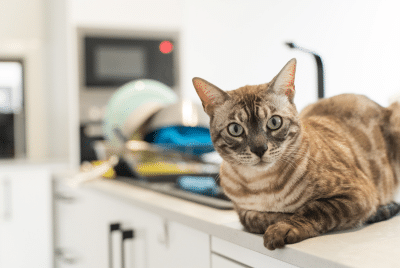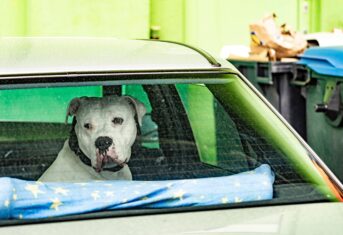5 Fire Safety Tips for Pet Families

5 Fire Safety Tips for Pet Families
National Fire Prevention Week, sponsored by the National Fire Prevention Association, is October 8-14. This year’s theme is “Cooking Safety Starts with You.” While pets don’t cook, they can start kitchen fires and are sadly victims of housefires. In 2021, CNN reported on cats causing kitchen fires by jumping on stoves with touch sensitive buttons. Once the cats turned the stove on, it overheated and caught fire. In this blogpost, I’ll discuss the pet health hazards of house and apartment fires and what you can do to keep your family safe.
Smoke Inhalation in Pets
Veterinarians from the Schwarzman Animal Medical Center’s Level 1 Trauma Center are no strangers to pets caught in house or apartment fires. They know that smoke inhalation can be much worse than burns. Fires produce carbon monoxide, which binds to the oxygen-transporting protein hemoglobin, creating carboxyhemoglobin. Carboxyhemoglobin cannot carry oxygen and, in severe cases, prevents adequate oxygenation of important organs. Pets with elevated carboxyhemoglobin need oxygen therapy, at minimum, and sometimes a ventilator to provide oxygen until their hemoglobin molecules recover. The lack of oxygen caused by exposure to carbon monoxide is particularly damaging to the heart and brain, both organs with a high demand for oxygen. AMC has the ability to measure carboxyhemoglobin in pets with smoke inhalation and use this information to guide patient management. AMC veterinarians recently cared for a cat with elevated carboxyhemoglobin. After 24 hours in the oxygen cage, she was discharged to her traumatized family with normal levels of carboxyhemoglobin.
Other Fire Related Injuries in Pets
Burns are the obvious fire related injury, but burns are less common than some of the other fire related injuries. Corneal ulcers and heatstroke occur frequently in pets trapped in a house fire. Exposure to toxins and particulate matter in smoke can damage the entire respiratory tree, nose, windpipe and lungs, complicating recovery. The amount of damage depends on what substance was burning, the duration of the smoke exposure and if the pet’s proximity to the fire. For these reasons, two pets in the same house fire may not have the same outcome.
Fire Safety Tips for Your Kitchen, Your Home and Your Pet
- Purchase a stove with a lock function to prevent pets from inadvertently turning on the stove.
- Use child-proof stove knob covers to keep your pet from inadvertently turning on the stove, or purchase stove safety knobs if you have pets.
- Don’t leave flammable objects on or near the stove, such as paper towels or cooking oil.
- Don’t forget to “Change Your Clocks, Change Your Batteries” when the end of daylight savings time comes next month to ensure your smoke and carbon monoxide detectors are working properly.
- Check out the great resources the National Fire Prevention Association has available every day, not just for National Fire Prevention Week.

































